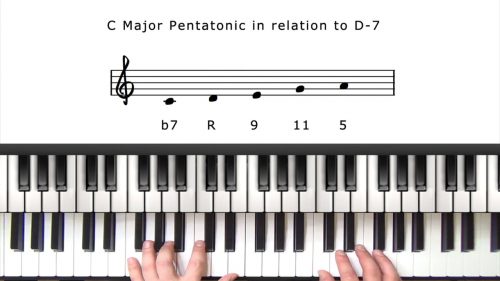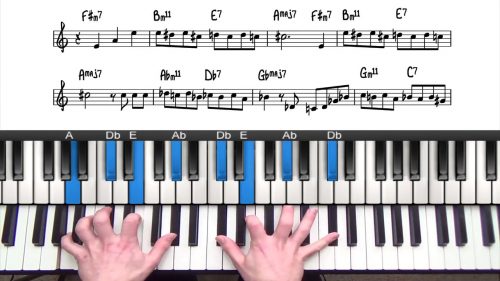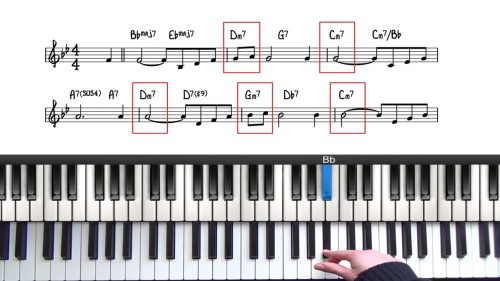Pentatonic Chord Voicings
In this lesson I’m going to introduce you to the concept of pentatonic harmony. This lesson is closely related to the ‘Pentatonic Improvisation’ lesson so if you haven’t watched that tutorial I’d recommend you check that out first.
As with all lessons I’ll demonstrate how you could apply the theory concept to a jazz standard. The application of pentatonic harmony is so vast so this is literally the tip of the iceberg but we will be adding this theory into future jazz standard lessons and also looking at utilising these sounds for fills, introductions and endings.
The jazz standard I have chosen to demonstrate pentatonic harmony in action is ‘What Are You Doing The Rest Of Your Life’ which is one of my all time favourites. I’ve chosen this tune because it has particularly rich harmony.
We’re are going to start off with a simple example and then move onto something more challenging.
Lesson Downloads
-
Major Pentatonic Scales In 12 Keys File Type: pdf
-
Pentatonic Scale Choices Cheat Sheet File Type: pdf
Practice Tips
-
Watch the pentatonic scales lesson which is the foundation of the theory for pentatonic voicings.
-
Learn the voicings in C Major and apply these to a tune that you are working on.
-
Learning these voicings in all 12 keys is a lot of 'heavy lifting' so be realistic about how long this will take.
-
The most important thing is the understand that 1 set of voicings can be used over many different chord types. This is demonstrated at ~7:30s in the tutorial.






Fascinating stuff – I’m going to have to watch the Michel Legrand tutorial to get up to speed on this but couldn’t resist pressing on to see the examples of pentatonic harmony in action… I’ve begun working on the C pentatonic sequence and see why it’s going to take some time! I was wondering if these harmonies are related to the so-called “miracle voicings” that some jazz books use, and that also use a lot of quartal intervals. I remember having just as much trouble memorizing those in ii-V-Is and just decided to stick with rootless voicings at some point. The end of the tutorial does a really good job of explaining how to use pentatonics to expand your harmonic pallete so now that I know what the destination can be I’m prepared to persevere more than with miracle voicings.
Thanks Martin!
Good day Hayden
I just signed up yesterday with the Pro membership and I immediately learned something new. I mostly play Bebop, but I want to get more ideas with my improvisation and the way you construct the lessons are more in a modern style which I like so I thought why not mix Modal theory with Bebop.
My question is what lessons in your library can I check out to further my ideas of how to improvise and get more ideas in the bridge of a song? I only play Bebop in the bridge of all my songs, but it would be nice to lengthen the improv section by applying new ideas like Modal and pentatonic ideas.
Best, Stephan
Hey Stephan,
Firstly welcome to PianoGroove Pro.
Here is a more detailed breakdown of each video and what improv concepts are covered. These lessons address general improvisation concepts that you can apply to any jazz standard:
Blue In Green Improvisation (covers general improve concepts: arpeggios, extending arpeggios, altered arpeggio shapes, approach patterns, enclosures, turns, chord tone soloing, choosing long notes carefully, ) watch lesson here:
Tenderly Part 2 (breaks down the runs and licks from the 1st lesson on tenderly) watch lesson here: https://www.pianogroove.com/jazz-piano-lessons/improvising-blue-in-green/
This Masquerade Improv (blues scale and how to combine blues scales with other modal scales, starting with a simple idea of 1 or two notes, starting phrases off the beat, changing your outlook on ‘wrong notes’… there are none!, improvising with triadic shapes) watch lesson here: https://www.pianogroove.com/jazz-piano-lessons/this-masquerade-improvisation/
1625 & 436251 (Discusses creating improvised introductions for any jazz standard) watch lesson here:
Approach Patterns & Enclosures This is a very focused improv tutorial on always having a place in mind to resolve your lines. The concepts we look at are target notes, approach patterns and chromaticism. Understanding these principles will add structure to your lines and will help you solos sound more interesting and professional. watch lesson here: https://www.pianogroove.com/jazz-piano-lessons/1625-436251-progressions/
Altered Scale Improvisation The altered mode is an extremely useful scale for playing over altered dominant chords. It sounds very exotic and jazzy. We also look at using the iRealPro App to keep us in time… id recommend downloading it. I have both the desktop and mobile versions and use it most days for playing over jazz standards. watch lesson here: https://www.pianogroove.com/jazz-piano-lessons/altered-scale-improv/
Locked Hands Improv This is more advanced, watch the Approach Pattern improv lesson first as we use the same tune “Alone Together” watch lesson here: https://www.pianogroove.com/jazz-piano-lessons/locked-hands-improvisation/
Pentatonic Improvisation This is quite an accessible topic for beginners – if you are interested in the ‘East Coast’ sound (think of McCoy Tyner and John Coltrane) then you will like the sound of pentatonic improvisation. watch lesson here: https://www.pianogroove.com/jazz-piano-lessons/pentatonic-scale-improvisation/
Hope this helps!
Thanks,
Hayden
Hayden:
Where do I find the intro to the pentatonic lesson?
Thank you,
Hector
Hi Hector,
Here is the lesson I created on pentatonic improvisation: https://www.pianogroove.com/jazz-piano-lessons/pentatonic-scale-improvisation/ – this is listed in the “Related Lessons” section of this page.
The website search feature can also be handy to find related lessons, for example: https://www.pianogroove.com/?s=pentatonic – this will return any lesson pages which contain the word “pentatonic”.
Please let me know if I can be of further assistance.
Talk soon,
Hayden
Great lesson. Thanks.
Now I know where this comes from.